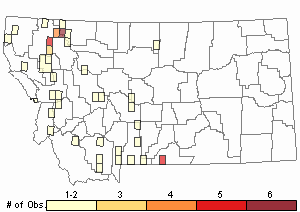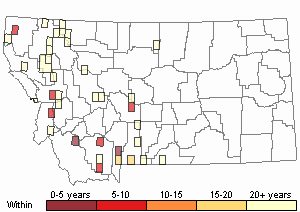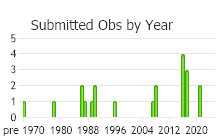View in other NatureServe Network Field Guides
NatureServe
Montana
Utah
Wyoming
Idaho
Wisconsin
British Columbia
South Carolina
Yukon
California
New York
An Orthotrichum Moss - Orthotrichum laevigatum
Other Names:
Orthotrichum laevigatum form macounii
General Description
Plants: Acrocarpous, growing in loose (FNA 2014) or sometimes crowded (Lawton 1971) clumps or cushions of upright shoots (FNA 2014), green or green with yellow tones (Lawton 1971). Stems 5-43 mm in height, usually about 20 mm (FNA 2014), frequently forked (Lawton 1971).
Leaves: Upright, pressed next to the stem, overlapping, and a little bent toward one side when dry, spreading, sometimes broadly, when damp, 2-4.3 mm in length, lance-shaped with ovate tendencies or somewhat oblong, the apex obtuse, slenderly acute or dulled, occasionally acuminate; leaf edges smooth, curved or rolled back from the bottom nearly to the leaf apex (FNA 2014); costa reaching or almost reaching the leaf tip (Lawton 1971).
Leaf Cells: Upper laminal cells arranged in layer (FNA 2014), chlorophyllous (Crum & Anderson et al., 1981), somewhat round and isodiametric, with 1-3 cone-shaped or 2-lobed papillae per cell; lower laminal cells quadrangular and somewhat long to nearly square (and somewhat elliptical), with thick, knobby walls (FNA 2014).
Diagnostic Characteristics
Orthotrichum laevigatum intergrades with O. pylaisii, but O. pylaisii has exostome teeth bent back and downward rather than upright and the endostome is typically present in at least some capsules rather than lacking in capsules with open lids as in O. laevigatum (FNA 2014).
Range Comments
North American Range
AK to NT, BC to MB, s to CA, AZ and CO, also SD (FNA 2014). Known in Montana from Carbon, Carter, Fergus, Flathead, Gallatin, Glacier, Granite, Hill, Judith Basin, Lake, Lewis and Clark, Lincoln, Madison, Missoula, Park, Ravalli, Sanders, and Sweet Grass Counties (Elliott & Pipp, 2016).
Observations in Montana Natural Heritage Program Database
Number of Observations: 78
(Click on the following maps and charts to see full sized version)
Map Help and Descriptions
Relative Density

Recency



 (Observations spanning multiple months or years are excluded from time charts)
(Observations spanning multiple months or years are excluded from time charts)
Habitat
Large, non-calcareous stones in uncrowded evergreen woods. Occurring at elevations from about 1640 to 9840 feet (FNA 2014).
Reproductive Characteristics
Autoicous. Seta twisted, 1.5-4 mm tall, carrying the capsule completely beyond the perichaetial bracts. Capsule 1.4-2.6 mm in length (FNA 2014), typically shorter than the seta (Lawton 1971), smooth or sometimes faintly pleated above; stomata at the surface; prostome scarcely developed if present; exostome of 16 upright teeth, papillose (FNA 2014), the striations variable (Lawton 1971); endostome processes 8, sometimes not much developed (typically not present when capsule is open). Calyptra cone-shaped to somewhat oblong, sheltering the full length of the capsule, the few hairs with small papillae (FNA 2014).
Stewardship Responsibility
References
- Literature Cited AboveLegend:
 View Online Publication
View Online Publication Crum, H.A. and L.E. Anderson. 1981. Mosses of Eastern North America. 2 volumes. Columbia University Press, New York. 1328 pp.
Crum, H.A. and L.E. Anderson. 1981. Mosses of Eastern North America. 2 volumes. Columbia University Press, New York. 1328 pp. Elliott, J.C. and A.K. Pipp. 2018. A Checklist of Montana Mosses (1880-2018). Updated 3 January, 2020. Montana Natural Heritage Program, Helena, Montana. 73 pp.
Elliott, J.C. and A.K. Pipp. 2018. A Checklist of Montana Mosses (1880-2018). Updated 3 January, 2020. Montana Natural Heritage Program, Helena, Montana. 73 pp. Flora of North America Editorial Committee, eds. 2014. Flora of North America North of Mexico. Volume 28. Bryophytes: Mosses, Part 2. Oxford University Press, Inc., NY. xxi + 702 pp.
Flora of North America Editorial Committee, eds. 2014. Flora of North America North of Mexico. Volume 28. Bryophytes: Mosses, Part 2. Oxford University Press, Inc., NY. xxi + 702 pp. Lawton, E. 1971. Moss Flora of the Pacific Northwest. Hattori Botanical Laboratory. Japan: Yamabuki-cho, Shinjuku-ku, Tokyo. 362 pages plus appendices.
Lawton, E. 1971. Moss Flora of the Pacific Northwest. Hattori Botanical Laboratory. Japan: Yamabuki-cho, Shinjuku-ku, Tokyo. 362 pages plus appendices.
- Additional ReferencesLegend:
 View Online Publication
View Online Publication
Do you know of a citation we're missing? Elliot, J. C. 1993. Second checklist of Montana mosses. Unpublished report. U.S. Forest Service, Region 1. Missoula, MT. 45 pp.
Elliot, J. C. 1993. Second checklist of Montana mosses. Unpublished report. U.S. Forest Service, Region 1. Missoula, MT. 45 pp. Flowers, S. 1973. Mosses: Utah and the West. Brigham Young University, Provo, Utah. 567 p.
Flowers, S. 1973. Mosses: Utah and the West. Brigham Young University, Provo, Utah. 567 p. Lawton, E. 1971. Keys for the Identification of the Mosses on the Pacific Northwest. Reprinted from 'Moss Flora of the Pacific Northwest'. Published as Supplement No. 2 of the Journal of the Hattori Botanical Laboratory. Nichinan, Miyazaki, Japan. 66 pp.
Lawton, E. 1971. Keys for the Identification of the Mosses on the Pacific Northwest. Reprinted from 'Moss Flora of the Pacific Northwest'. Published as Supplement No. 2 of the Journal of the Hattori Botanical Laboratory. Nichinan, Miyazaki, Japan. 66 pp. Malcolm, B., N. Malcolm, J. Shevock, and D. Norris. 2009. California Mosses. Nelson, New Zealand: Micro-Optics Press. 430 pp.
Malcolm, B., N. Malcolm, J. Shevock, and D. Norris. 2009. California Mosses. Nelson, New Zealand: Micro-Optics Press. 430 pp. Smith, A.J.E. 1980. The Moss Flora of Britain and Ireland. Cambridge University Press, Cambridge. 705 pp.
Smith, A.J.E. 1980. The Moss Flora of Britain and Ireland. Cambridge University Press, Cambridge. 705 pp.
- Web Search Engines for Articles on "An Orthotrichum Moss"





